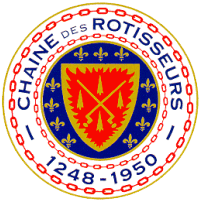Confrérie de la Chaîne des Rôtisseurs facts for kids
La Confrérie de la Chaîne des Rôtisseurs is a special international club for people who love food and cooking. It was started in Paris, France, in 1950. It's one of the oldest food clubs in the world!
The club's name comes from an old French group called the Royal Guild of Goose Roasters. This old group used to roast all kinds of poultry, meat, and game. It stopped existing in the late 1700s.
Contents
History of the Chaîne
The Chaîne des Rôtisseurs gets its name from a very old group of French cooking guilds. These were like professional clubs for cooks.
The Goose Roasters Guild
The written history of the "Goose Roasters" guild goes back to 1248. At that time, King Louis IX of France wanted to organize different jobs and guilds. He asked Étienne Boileau, a leader in Paris, to help.
Étienne Boileau collected the rules for over 100 different jobs. The Goose Roasters were one of these groups. They helped train young cooks and improve their skills.
Over many years, the Goose Roasters Guild was allowed to prepare and sell more types of meat. This included poultry (like chickens) and venison (deer meat).
Becoming the Rôtisseurs
In 1509, during the time of King Louis XII, new rules were made. The guild's name changed to "Rôtisseurs." Their work then focused on poultry, game birds, lamb, and venison.
In 1610, under King Louis XIII, the guild received a special royal paper. This paper gave them their own official coat of arms.
For over 400 years, this "Confrérie" or brotherhood of Roasters worked to improve cooking skills. They set high standards for quality, even for the King's own meals. However, this old guild system ended in the 1700s during the French Revolution.
The Chaîne Today
The name "Chaîne des Rôtisseurs" was brought back in Paris in 1950. A group of friends who loved food and wine decided to restart the club.
Since then, the club has started "bailliages" or local chapters all over the world. As of 2022, the organization had chapters in 80 different countries.
Joining the Club
Local chapters often host special dinners for their members. You can only become a member if you are invited. In the United States, for example, the first year's membership fee in 2016 was around $625. This included a fee to join the club.
Most chapters do not require members to be professional chefs. Anyone who loves food can join! When new members are welcomed, they receive special ribbons. These ribbons show their type and level of membership. Members can also earn pins and medals for helping out at events.
Competitions and Awards
The Chaîne des Rôtisseurs organizes exciting cooking competitions for young chefs.
Young Chefs Competition
One competition is for young chefs under 27 years old. It's called the Jeunes Chefs Rôtisseurs. A professional member of the Chaîne sponsors this event. You can find more information about it online.
This competition is a "black box" challenge. This means the chefs do not know what ingredients they will use until the competition starts. They have 30 minutes to plan a menu. Then, they have three and a half hours to cook a three-course meal for four people.
Young Sommeliers Competition
The organization also holds competitions for young sommeliers. Sommeliers are experts in wine and how it pairs with food. This competition is called the Jeunes Sommeliers.
Brillat Awards
In the USA, some chapters also give out Brillat awards. These awards are named after a famous food writer, Jean Anthelme Brillat-Savarin. They are given to local chefs.
Notable Members






